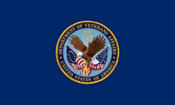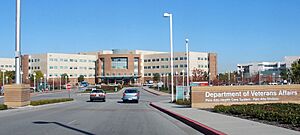United States Department of Veterans Affairs facts for kids

Seal of the Department of Veterans Affairs
|
|

Flag of the Department of Veterans Affairs
|
|
 Washington, D.C. Headquarters |
|
| Agency overview | |
|---|---|
| Formed | July 21, 1930 |
| Preceding agency |
|
| Jurisdiction | United States federal government |
| Headquarters | Veteran Affairs Building 810 Vermont Avenue NW Washington, D.C., U.S. 38°54′04″N 77°02′06″W / 38.90111°N 77.03500°W |
| Employees | 412,892 (June 2020) |
| Annual budget | FY2022: $112.2 billion (appropriated) FY2023: $301.4 billion (requested) |
| Agency executives |
|
| Child agencies |
|
The United States Department of Veterans Affairs (VA) is a special part of the U.S. government. It's like a main department, led by a person who is part of the President's Cabinet. The VA's main job is to provide healthcare and other important services to military veterans. These are people who have served in the U.S. armed forces.
The VA runs about 170 medical centers and clinics across the country. Besides healthcare, they offer many other benefits. These include money for disabilities, help with job training, education support, home loans, and life insurance. The VA also helps with burial and memorial services for veterans and their families at 135 national cemeteries.
The U.S. government has helped veterans since the American Revolutionary War. However, a specific agency for veterans wasn't created until 1930. It was first called the Veterans' Administration. In 1982, its role grew to include helping civilians during national emergencies. Then, in 1989, it became a full department, the Department of Veterans Affairs. The President chooses the Secretary of Veterans Affairs, who leads the department and is a member of the Cabinet.
As of June 2020[update] the VA had over 412,000 employees. They worked at many medical facilities, clinics, offices, and cemeteries. In 2016, the department's costs were about $273 billion. This included money for disability payments and other long-term benefits for veterans and their families.
Contents
How the VA Started and Grew
The story of the U.S. Department of Veterans Affairs is closely linked to America's wars. The VA takes care of former soldiers and other military veterans who were wounded or need support. The U.S. has been involved in many wars throughout its history. Most of the military casualties happened in eight major wars. These include the American Revolutionary War, the American Civil War, World War I, World War II, the Korean War, the Vietnam War, the Iraq War, and the War in Afghanistan. These conflicts have shaped what the VA does and how it has changed over time.
Early Help for Veterans
Back in 1776, during the American Revolutionary War, the Continental Congress offered pensions to soldiers who were disabled. They also gave land to those who served in the Continental Army. At first, individual states and communities provided medical care. In 1811, the federal government approved the first special facility for veterans. It was called the Philadelphia Naval Asylum and opened in 1834.
During the 1800s, help for veterans grew. It included benefits and pensions for veterans, their widows, and their children. After the American Civil War in 1865, a nurse named Delphine Baker helped create national homes for Civil War veterans. These homes were similar to existing homes for active-duty soldiers. The bill to create the National Home for Disabled Volunteer Soldiers passed on March 3, 1865.
The very next day, President Abraham Lincoln spoke about caring for veterans in his second inaugural address. He said, "to care for him who shall have borne the battle, and for his widow, and his orphan." This idea later became a guiding principle for the Department of Veterans Affairs.
While the National Home system managed care for Civil War veterans, different agencies handled pension benefits. The Bureau of Pensions managed money for veterans, widows, and children. After the Civil War, the number of people receiving pensions grew a lot. Many states also set up their own veterans' homes. These homes provided medical care for all injuries and diseases, whether they were from military service or not.
Creating the Veterans' Bureau
When the United States entered World War I in 1917, the number of veterans grew hugely. This overwhelmed the existing system. In 1920, Warren G. Harding, who was running for president, promised to help the millions of Americans who served in the war. At that time, veterans had to deal with three different federal agencies to get benefits. This made it very confusing.
After winning the election, President Harding signed a law on August 8, 1921. This law created the Veterans' Bureau. This new bureau combined several existing agencies. In 1922, it also took over many veterans' hospitals from the Public Health Service. These hospitals were often on former U.S. Army bases.
A key part of the new law was making it easier for veterans to claim two specific disabilities: tuberculosis and certain mental health conditions. This was important because it set a new standard for future claims.
By the 1920s, three main federal agencies handled veteran benefits. To make things simpler, President Herbert Hoover signed an order on July 21, 1930. This order merged all three agencies into one: the Veterans' Administration.
World War II and the GI Bill
In 1940, as war spread in Europe and Asia, the VA started getting ready for the U.S. to join the conflict. They worked with the War Department to plan for more hospital beds and medical staff.
When the U.S. entered World War II after the attack on Pearl Harbor, the Army needed many doctors and healthcare workers. This meant that civilian hospitals and the VA lost staff. To help, the War Department and the VA agreed to share medical personnel. Some VA doctors were even inducted into the Army but allowed to stay at VA facilities. One famous person who wore this special patch was General Omar Bradley.
After World War II, the number of veterans increased greatly. Congress also passed many new benefits for them. The VA had to deal with both new World War II veterans and aging World War I veterans. To handle the large number of people, the VA changed its structure. It gave more power to its local offices instead of keeping everything in Washington, D.C.
A very important law was the Servicemen's Readjustment Act, also known as the GI Bill. President Franklin D. Roosevelt signed it into law on June 22, 1944. This bill had a huge impact on American life. Unlike earlier laws, the GI Bill said that the VA would manage all its benefits. Later, similar education benefits were created for veterans of the Korean War.
Becoming a Cabinet Department
The Department of Veterans Affairs Act of 1988 changed the Veterans' Administration into a Cabinet-level department. President Ronald Reagan signed the law on October 25, 1988. It officially took effect on March 15, 1989, under President George H. W. Bush.
From 1995 to 2000, the Veterans Health Administration (VHA) greatly improved its healthcare services. It used a national electronic health system to provide better care. This led to more patients being treated and better quality of care.
In 2008, the Post-9/11 Veterans Educational Assistance Act of 2008 was passed. This law, also known as the new GI Bill, greatly increased college benefits for veterans. It could cover full scholarships at in-state public universities for veterans who served at least three years. It also added a monthly housing payment. The Department of Defense (DoD) also allowed some service members to transfer their unused education benefits to their spouses or children.
In 2014, there were concerns about veterans having trouble getting timely medical care at some VA facilities. The Secretary of Veterans Affairs, Eric Shinseki, resigned because of these issues. He stated that the problems with patient wait times were widespread and unacceptable.
In 2023, the VA adopted a new mission statement. It is: "To fulfill President Lincoln's promise to care for those who have served in our nation's military and for their families, caregivers, and survivors." This statement shows the VA's ongoing commitment to veterans.

What the VA Does
The main job of the VA is to support veterans after their military service. It provides them with benefits and help.
In 1982, Congress added a "fourth mission" to the VA's role. This means the VA can provide medical care to non-veteran civilians or military patients if hospitals are too full during a crisis. This happens during major disasters or emergencies declared by the President. State governors can ask for VA help through other federal agencies. The VA can also provide emergency medical care to non-veterans for a fee. For example, in March 2020, the VA shared its plan for responding to the COVID-19 pandemic in its medical facilities.
One important goal of the VA is to prevent and end veterans' homelessness. The VA works with other government groups to achieve this. They have made good progress, reducing veteran homelessness by a significant amount since 2010.
The VA also helps other government agencies get medical supplies. It does this through its Federal Supply Schedules Program.
How the VA is Organized
The Secretary of Veterans Affairs leads the Department of Veterans Affairs. The President chooses this person, and the Senate must approve the choice.
The current Secretary of Veterans Affairs is Doug Collins. There is also a Deputy Secretary and a Chief of Staff. The VA has ten other leaders who are chosen by the President and approved by the Senate.
The department has three main parts, called administrations. Each is led by an undersecretary:
- Veterans Health Administration (VHA): This part provides healthcare, does medical research, and runs clinics and medical centers.
- Veterans Benefits Administration (VBA): This part handles veteran registration, decides who is eligible for benefits, and manages programs like home loans, insurance, job training, education (GI Bill), and disability payments.
- National Cemetery Administration: This part provides burial and memorial benefits and takes care of VA cemeteries.
There are also assistant secretaries for different areas, like working with Congress, planning, human resources, and security.
As of 2017, the VA employed over 377,000 people. About one-fourth of these employees are veterans themselves.
Veterans Benefits Administration Services
The VA, through its Veterans Benefits Administration (VBA), offers many services to veterans. These include:
- Disability payments
- Pensions
- Education benefits (like the GI Bill)
- Home loans
- Life insurance
- Job training and rehabilitation
- Benefits for survivors of veterans
- Healthcare (managed by the VHA)
- Burial benefits (managed by the National Cemetery Administration)
The Department of Labor also helps veterans find jobs and get job training.
National Cemetery Administration Services
In 1973, the Department of Veterans Affairs took over the National Cemetery System. This meant the VA became responsible for most national cemeteries, except for Arlington National Cemetery.
Five years later, Congress created the State Cemetery Grants Program. This program helps states and U.S. territories build, expand, and improve cemeteries for veterans.
The National Cemetery Administration (NCA) is a part of the VA. Its main job is to provide burial and memorial benefits to eligible veterans and their families. It honors veterans by making sure they have respectful burials in national cemeteries.
Key things the NCA does:
- Running and Keeping Up Cemeteries: The NCA manages and maintains national cemeteries across the U.S. They make sure these places are well-kept and respectful.
- Burial Services: The NCA offers different burial choices. These include in-ground burials for caskets, spaces for cremated remains, and sometimes private family plots.
- Headstones and Markers: The NCA provides headstones, markers, and medallions for eligible veterans' graves. This is true whether they are buried in a national cemetery, a state veterans cemetery, or a private one.
- Memorial Programs: The NCA runs programs like the Presidential Memorial Certificate program. This program gives certificates with the President's signature to honor deceased veterans.
- Growing and Developing: The NCA plans and develops new national cemeteries. This ensures that veterans and their families will always have burial options in different parts of the country.
The NCA's main goal is to provide a final resting place that honors the service and sacrifice of veterans. This helps make sure their legacy is remembered for future generations.
Center for Women Veterans
The Center for Women Veterans (CWA) was created within the VA in 1994. Its mission is to:
- Keep an eye on how the VA provides healthcare, benefits, and programs for women veterans.
- Encourage people to recognize the service and contributions of women veterans and women in the military.
- Help people understand the importance of treating women veterans with dignity and respect.
The CWA does many things. It works with other government and non-government groups that help women veterans. It also serves as a place for women veterans and their families to find resources. The CWA educates VA staff about women's military contributions. It also makes sure that VA materials show and target women veterans. The CWA holds events to honor women veterans' service. It also runs a Women Veterans Call Center (1-855-829-6636) to help women veterans with VA services. In 2018, the CWA started the "I Am Not Invisible" photo project. This project features portraits to show the experiences of America's two million women veterans.
Costs for Veteran Care
The VA groups veterans into different priority groups. This helps decide what kind of care they receive and how much it costs. Factors like service-connected disabilities and income are used.
Veterans who have a 50% or higher disability that is connected to their military service (like losing a limb or having PTSD) get full healthcare and medicine for free. Veterans with fewer qualifying factors or higher incomes might have to pay a small fee for care not related to their service or for prescriptions. VA dental and nursing home care benefits have more rules.

Reservists and National Guard members who served in the U.S. during peacetime or have no service-related disabilities usually do not qualify for VA health benefits.
The VA's budget has been stretched in recent years, especially due to the War on Terrorism. Sometimes, there have been delays in giving veterans their disability ratings. This can be a problem because until veterans fully switch from military healthcare to VA care, they might have to pay for many healthcare costs themselves.
The number of pending disability claims at the VA has changed over time. In 2001, it was very high, but it went down in 2003. However, it increased again in 2005. These numbers are updated every Monday.
Veterans do not have to pay a copayment for VA services if their medical conditions are related to their military service. Many veteran service organizations, like the American Legion and Veterans of Foreign Wars, help veterans get care from the VA.
For the 2009 budget, President George W. Bush asked for a large amount of money for veteran medical care. Researchers have estimated that the cost of caring for veterans of the War on Terror will be very high in the future, possibly totaling hundreds of billions to a trillion dollars.
Related Laws for Veterans
Many laws have been passed to help veterans over the years. Here are some important ones:
- 1944: Mustering-out Payment Act
- 1944: Servicemen's Readjustment Act (the original GI Bill)
- 1944: Veterans' Preference Act
- 1952: Veterans' Readjustment Assistance Act
- 1974: Vietnam Veterans' Readjustment Assistance Act
- 1988: Department of Veterans Affairs Act (which made the VA a Cabinet-level department)
- 2006: Veterans Benefits, Health Care, and Information Technology Act of 2006 (this law helps veteran-owned small businesses get government contracts)
- 2013: FOR VETS Act of 2013
- 2013: Veterans Paralympic Act of 2013 (H.R. 1402; 113th Congress)
- 2014: Veterans Access, Choice, and Accountability Act of 2014
- 2017: Veterans Appeals Improvement and Modernization Act of 2017
- 2022: Honoring our Promise to Address Comprehensive Toxics (PACT) Act of 2022
Images for kids
See also
 In Spanish: Departamento de Asuntos de los Veteranos de los Estados Unidos para niños
In Spanish: Departamento de Asuntos de los Veteranos de los Estados Unidos para niños






